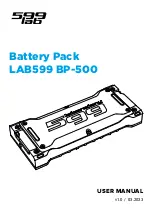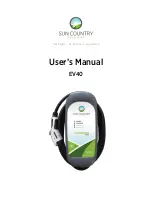
7.
Operation Modes and Display
7.1 Operation Modes:
Charge Mode: The rechargeable battery is charged up to its
maximum capacity. Accumulated charging capacity is displayed
at mAH display mode.
Discharge Mode: It is used to reduce the memory effect. The
rechargeable battery is discharged to a preset battery voltage
(0.9v). Once discharge is finished, total accumulated discharging
capacity is displayed at mAH display mode, showing how much
energy is discharged from the battery, which is always referring to
the accumulated discharging capacity. No trickle charge current
will be applied after discharge cycle is finished.
Refresh Mode: The rechargeable battery is charged and
discharged repeatedly to optimize to its maximum capacity. Old
rechargeable batteries or rechargeable batteries that have not
been used for a long period of time can be restored to their rated
capacity. Depends on the selected charge current and battery
impedance, it can take tens hours or even days time before
complete. Refresh mode will make 3 complete discharge-charge
working cycles before complete. After discharge cycle is
complete, the total discharged capacity will be displayed in mAH
display mode. When its current working cycle is in charging state,
the mAH display is always referring to last discharging cycle for
its charged capacity..
Test mode: Checks the present capacity of a rechargeable
battery. The maximum capacity is determined by discharging the
rechargeable battery after it was fully charged. If the maximum
capacity is much lower than the rated capacity then it may reach
the end of its lifetime.
Quick Test mode: The charger will analyze the dynamic internal
battery resistance by applying a load current and this current
reading is referred to the voltage drop detected on the battery.
Within 10s, the tested battery resistance will be displayed in the
unit of milliohm. For good quality batteries, the internal resistance
is very low: in the range of 20 ~ 80 milliohms. If battery internal
resistance is over 500milliohms, then these batteries are not
good for supplying power to high current loads, such as digital
camera etc. But they can still be used for low energy loads, such
as clock, remote controllers etc. Always use batteries with close
internal resistance range when they are used in serial to achieve
maximum battery life. Alkaline and any other 1.5v batteries can
be tested on this charger as well. If a completely empty battery is
to be tested, it is not possible to give any correct reading. Please
be noted that since the internal battery resistance can be very
small, and contact resistance can be a major influence factor,
thus same battery tested in different slot or even at the same slot
with different contact condition, the reading can be varied for 10%
to 20%. This is normal.
When a high impedance battery( e.g. Over 2500milli ohm) is
loaded onto the charger, due to its high internal impedance, real
displayed charging current can be much less than your
pre-selected charging current. When this happened, it doesn’t
mean the charger is defective. Eventually it needs longer
charging time until fully charged.
7.2 Display
Charge/Discharge Current: instantaneous current is displayed.
Time Elapsed: The charging/discharging time of the last cycle is
displayed.
Accumulated Capacity: The accumulated battery capacity is
displayed in mAh. For discharge mode, it is referring to the
accumulated energy discharged from that battery. For refresh mode,
previous charging capacity is displayed even when current working
stage is at discharge cycle.
Battery Voltage: The instantaneous battery voltage is displayed.
At QUICK TEST mode, it shows the internal battery resistance in
mili- ohm(0.001R).
Full: After the rechargeable battery is fully charged in any of the
operation modes, trickle charging will be started automatically.
Trickle charging prevents the rechargeable batteries from being
overcharged and compensates for self-discharging of the batteries
8.
Maintenance
The device is maintenance-free but should be cleaned occasionally. When
cleaning, the device must be removed from any power source. Only use
dry and soft cloth to clear the housing of the charger. Do not use abrasive
or solvents.
9.
Disposal
9.1 Disposal of waste electrical and electronic equipment
In order to preserve, protect and improve the quality of environment,
protect human health and utilize natural resources prudently and rationally,
the user should return unserviceable product to relevant facilities in
accordance with statutory regulations.
The crossed-out wheeled bin indicates the product needs to be disposed
separately and not as municipal waste.






















